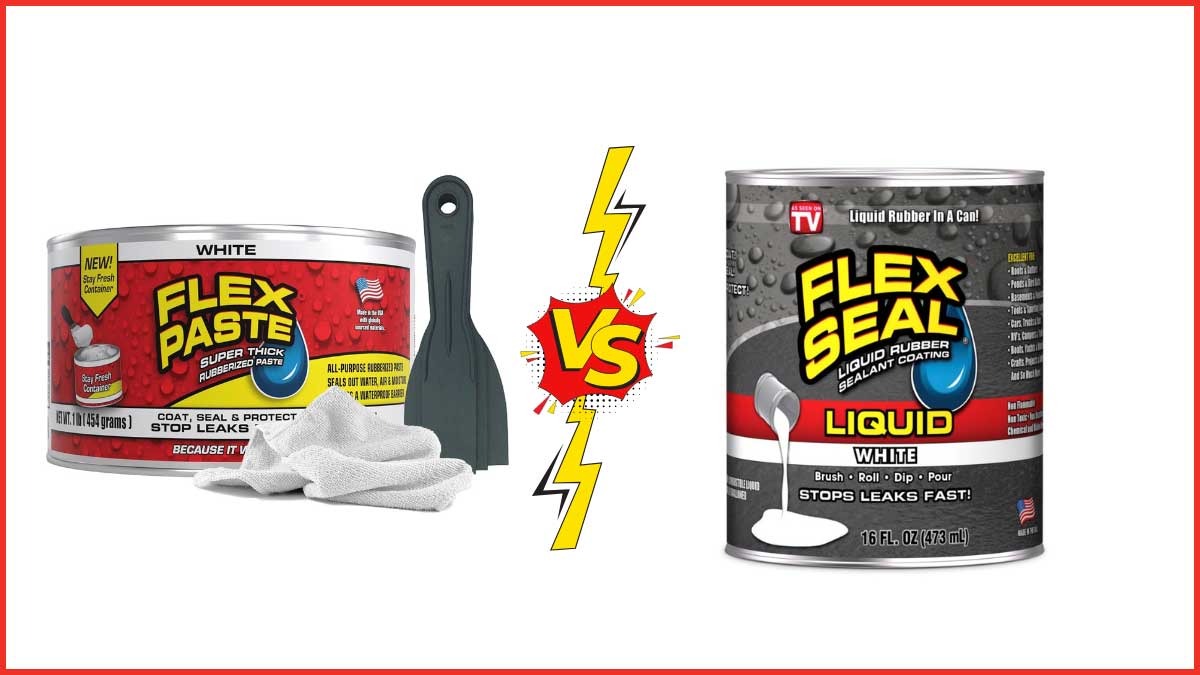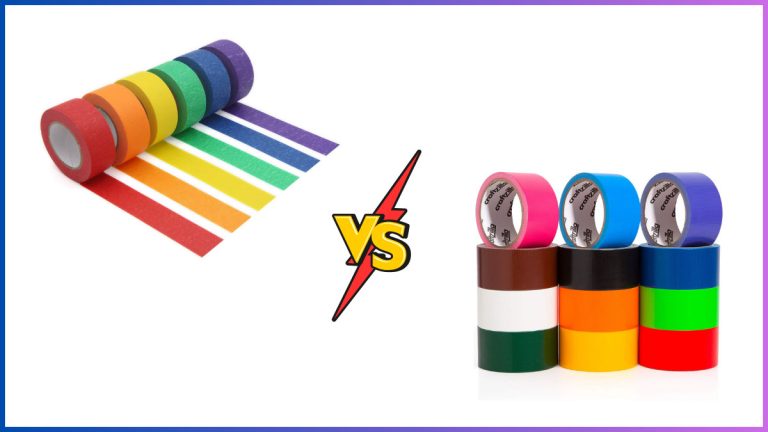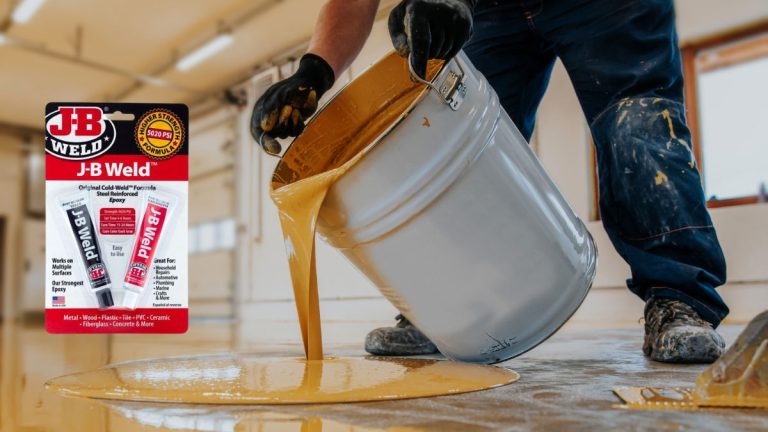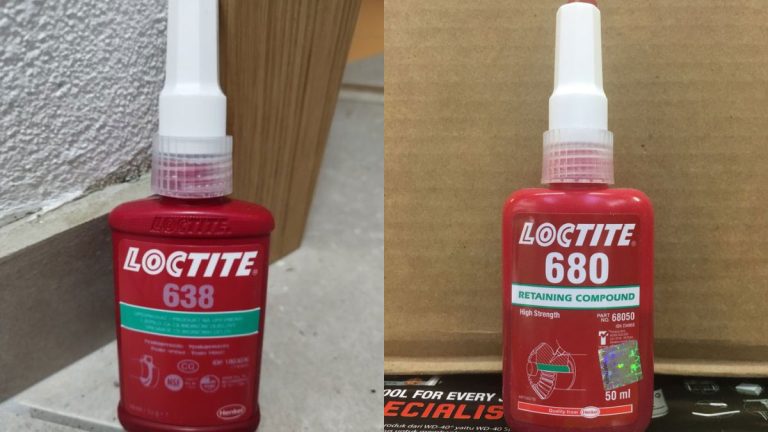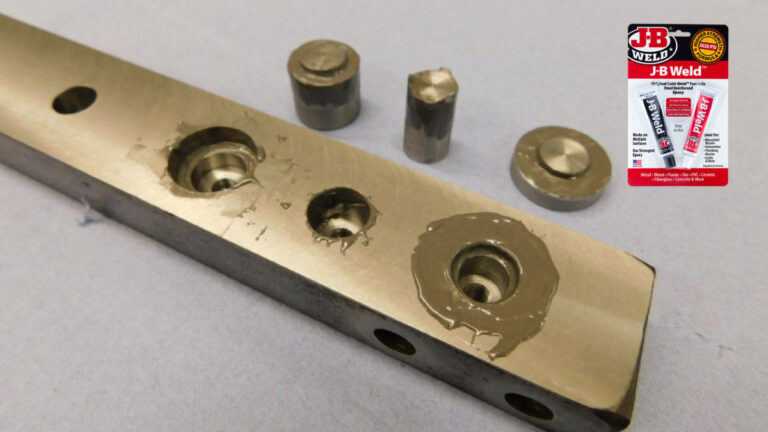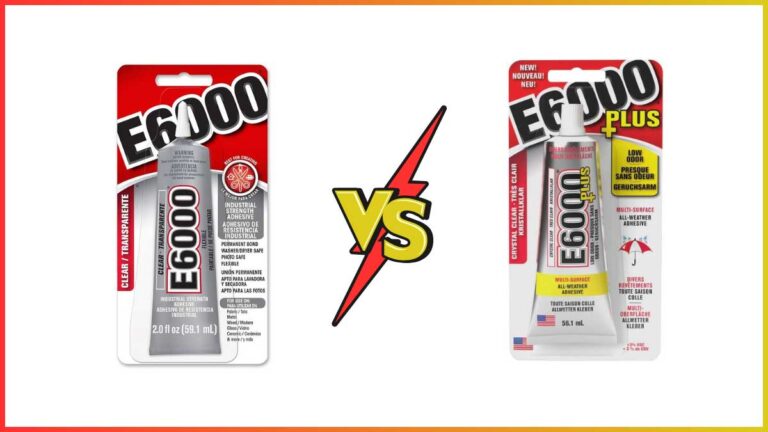Flex Paste vs Flex Seal: Which Is Best for Your DIY Needs?
When it comes to quick fixes and DIY projects, Flex Paste and Flex Seal often come up as top contenders. Both products promise to provide a strong, durable seal, but which one is right for your needs? Whether you’re dealing with a leaky pipe, a cracked roof, or a drafty window, understanding the differences between these two can save you time and money.
Flex Paste offers a thick, moldable solution perfect for filling gaps and sealing uneven surfaces. On the other hand, Flex Seal provides a liquid rubber coating that sprays on evenly, making it ideal for covering large areas quickly. By comparing their features, applications, and ease of use, you’ll be better equipped to choose the product that best suits your next project.
Key Takeaways
- Versatility and Applications: Flex Paste is suitable for thick, moldable applications like filling large gaps and cracks, even underwater, whereas Flex Seal is ideal for providing quick, even coverage for larger areas through spray or brush application.
- Durability and Resistance: Flex Paste forms a strong, watertight, UV, and mildew-resistant seal, making it durable for long-term solutions. Flex Seal offers a weather-resistant, flexible barrier but may not be as durable for heavy-duty applications.
- Ease of Use: Flex Paste requires application with a putty knife and thorough surface preparation, while Flex Seal can be easily sprayed or brushed onto surfaces, making it more convenient for quick fixes.
- Curing Time: Flex Paste begins to cure in 15-30 minutes and fully cures in 24-48 hours, which may delay project completion. Flex Seal dries to the touch in 2-3 hours and fully cures in 24 hours.
- Cost and Value: Flex Paste is generally more expensive but offers long-lasting, robust solutions. Flex Seal is cost-effective for temporary fixes and large area coverage.
- Customer Feedback: Users appreciate Flex Paste for its effectiveness in sealing large gaps and durability, though some find it pricey. Flex Seal is favored for its ease of use and versatility, but it sometimes faces issues with spray nozzle inconsistencies.
Overview Of Flex Paste And Flex Seal
What Is Flex Paste?
Flex Paste is a super thick, rubberized paste designed to instantly fill large gaps, cracks, and holes.
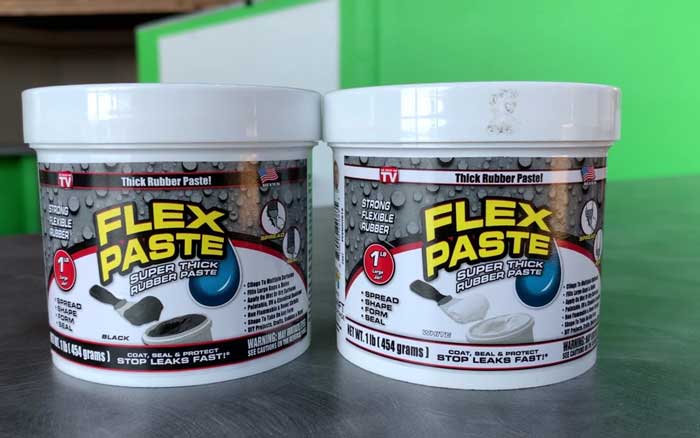
Key Characteristics
- Application: Clings to surfaces; applied using a putty knife or similar tool in a smooth, even motion.
- Properties: Dries into a strong, flexible, watertight, rubberized coating that seals out air, water, and moisture. It is UV, chemical, and mildew resistant.
- Surfaces: Versatile use on wood, glass, tile, concrete, aluminum, metal, brick, stucco, masonry, copper, fabric, fiberglass, ceramic, porcelain, natural stones, roofing, PVC, and more.
- Usage: Suitable for DIY projects, handyman repairs, arts and crafts, and more. Effective for sealing cracks, holes, and gaps underwater.
What Is Flex Seal?
Flex Seal is a liquid rubber coating that sprays on evenly to cover large areas.
- Application: Applied via aerosol spray, creating a uniform coating. Ideal for covering vast surfaces evenly.
- Properties: Forms a durable, flexible, water-resistant barrier. The coating can expand and contract without cracking.
- Surfaces: Works on metal, aluminum, wood, brick, concrete, masonry, fabric, glass, plastic, ceramic, porcelain, drywall, rubber, and more.
- Usage: Ideal for roofs, gutters, windowsills, foundations, basements, boats, RVs, campers, projects, and more. Perfect for small leaks, filling cracks, and preventing drafts.
- Opt for Flex Paste if you need a thick, moldable solution for filling large gaps, cracks, or uneven surfaces.
- Select Flex Seal if you’re looking to cover large areas quickly and evenly with a liquid rubber coating.
Key Features And Benefits
Understand the essential characteristics and advantages of Flex Paste and Flex Seal to help you choose the right product for your needs. Flex Paste stands out for its thick consistency and impressive adhesion, while Flex Seal offers convenient application and effective sealing for larger areas.
Flex Paste Features
Composition: Flex Paste is a super thick, rubberized paste.
Adhesion: It clings to practically any surface, instantly filling large gaps, cracks, and holes.
Water Resistance: It works and dries underwater, making it suitable for various applications, including marine repairs.
Durability: Once dry, it forms a strong, flexible, watertight, rubberized coating that seals out air, water, and moisture.
Resistance: It is UV and mildew resistant.
Application: Can be applied using a putty knife or similar tool. It requires a clean, dry surface, free of grease and oil, for optimal adhesion.
Curing Time: Begins to cure within 15-30 minutes and fully cures within 24-48 hours.
Flex Seal Features
Composition: Flex Seal is a thick, rubberized liquid.
Adhesion: It can be brushed, rolled, dipped, or poured onto surfaces.
Water Resistance: Seals out water and moisture, providing a protective barrier.
Durability: Forms a strong, flexible, weather-resistant coating once cured.
Resistance: It is UV and corrosion-resistant.
Application: Versatile application methods include spraying, brushing, rolling, or dipping. It can be used on wet or dry surfaces.
Curing Time: Typically dries to the touch within 2-3 hours and cures fully within 24 hours.
| Feature | Flex Paste | Flex Seal |
|---|---|---|
| Composition | Super thick rubberized paste | Thick rubberized liquid |
| Adhesion | Clings to any surface | Adheres via brush, roll, dip, pour |
| Water Resistance | Dries and works underwater | Seals and protects from moisture |
| Durability | Strong, flexible, watertight | Strong, flexible, weather-resistant |
| Resistance | UV, mildew-resistant | UV, corrosion-resistant |
| Application | Putty knife application | Versatile methods, including spray |
| Curing Time | Begins curing in 15-30 mins, fully cures in 24-48 hours | Dries in 2-3 hours, cures in 24 hours |
Choosing between Flex Paste and Flex Seal depends on the specific requirements of your project. For thick, moldable applications and underwater tasks, Flex Paste excels. For quick, even coverage of large areas, Flex Seal is ideal.
Application Process
Understanding how to apply both Flex Paste and Flex Seal is crucial for achieving the best results in your DIY projects. Follow these detailed instructions to ensure a successful application.
How to Apply Flex Paste
Preparation
- Clean the surface, ensuring it’s free from grease, oil, and dirt. Wear protective gloves, clothing, and eyewear for safety.
- Work in a well-ventilated area to avoid inhaling any fumes.
Application
- Remove the silica packet and foil from the container. Keep these for storage.
- Use a putty knife or similar tool to scoop out the Flex Paste.
- Apply a generous amount to the surface using a smooth, even motion.
- For wet or underwater surfaces, etch the surface to enhance adhesion.
Drying and Curing
- Allow each coat to dry fully before applying the next. Flex Paste begins curing in 15-30 minutes and fully cures in 24-48 hours depending on temperature and humidity levels.
Storage
- Store in an air-conditioned, humidity-controlled environment. Ensure the lid is firmly closed to preserve the product.
How to Apply Flex Seal
Preparation
- Clean and dry the surface before application. For best results, ensure it’s free from dust and debris.
- Shake the can well if using a spray application method.
Application
- Hold the can 8-12 inches from the surface if spraying. Use a steady back-and-forth motion to apply a uniform coat.
- For brushing, pour the Flex Seal into a container and use a brush to apply it evenly.
- Apply multiple coats for a thicker layer, allowing drying time between each coat.
Drying and Curing
- Flex Seal dries to the touch within 2-3 hours. Full curing occurs in 24 hours, at which point the surface will be fully weather-resistant.
Storage
- Store in a cool, dry place. Close the lid tightly after each use to maintain the product’s effectiveness.
Comparison Table
Here’s a detailed comparison to help you decide which product suits your needs:
| Feature | Flex Paste | Flex Seal |
|---|---|---|
| Application | Putty knife for thick, moldable fixes | Spray or brush for large areas |
| Cure Time | 24-48 hours | 24 hours |
| Dry to Touch | 15-30 minutes | 2-3 hours |
| Environment | Works underwater, UV, mildew resistant | Weather-resistant, UV resistant |
| Storage | Air-conditioned, humidity-controlled | Cool, dry place |
Using these steps and this comparison, you can strategically decide which product best meets your specific repair or DIY needs.
Effectiveness
Understanding the effectiveness of Flex Paste and Flex Seal is crucial for choosing the right product for your projects.
Flex Paste
Sealing Gaps and Holes: Flex Paste is highly effective at filling gaps and holes. It clings well to various surfaces, forming a strong, flexible, rubberized, and watertight coating that seals out air, water, and moisture.
Underwater Use: It can dry and cure underwater, perfect for applications where water is present.
Multiple Surfaces: Flex Paste adheres to many surfaces including:
- Wood
- Glass
- Tile
- Concrete
- Aluminum
- Metal
- Brick
- Stucco
- Masonry
- Copper
- Fabric
- Fiberglass
- Ceramic
- Porcelain
- Natural stones
- Roofing
- PVC
Flex Seal Liquid
Temporary Fixes: Flex Seal Liquid is often used for temporary minor patches. It may not be as durable as Flex Paste for long-term solutions.
Durability And Performance
The durability and performance of each product depend on the application and the conditions they’re exposed to.
Flex Paste:
- Long-Lasting: Offers long-term solutions due to its robust nature.
- Chemical Resistant: Resists chemicals, preventing degradation.
- UV Resistant: Withstands sun exposure, reducing wear and tear.
- Mildew Resistant: Prevents mold growth, ideal for humid environments.
- Curing Time: Typically cures within 24-48 hours.
Flex Seal Liquid:
- Weather Resistant: Provides a flexible, weather-resistant barrier.
- UV Resistant: Resists UV damage but may not be as durable as Flex Paste.
- Curing Time: Dries to the touch in 2-3 hours, fully cures in 24 hours.
Versatility And Use Cases
The versatility of Flex Paste and Flex Seal Liquid makes them suitable for various applications.
Flex Paste:
- Wide Range: Applicable on multiple surfaces, useful for both minor and major repairs.
- Complex Repairs: Effective for large gaps, cracks, and holes.
- Special Environments: Works in underwater scenarios.
- Quick Coverage: Ideal for covering larger areas quickly.
- Ease of Use: Sprays on evenly, convenient for patches.
- Diverse Applications: Suitable for roofs, gutters, and foundations.
Here is a data-rich comparison table to help you easily assess the key features of each product:
| Feature | Flex Paste | Flex Seal Liquid |
|---|---|---|
| Sealing Ability | Fills large gaps/holes | Minor patches |
| Underwater Use | Yes | No |
| Surface Types | Multiple | Multiple |
| Curing Time | 24-48 hours | 24 hours |
| Durability | UV, chemical, mildew resistant | Weather-resistant |
| Application | Putty knife | Spray, brush |
Choosing between Flex Paste and Flex Seal depends on the specific demands of your project. Flex Paste offers robustness and versatility for a range of surfaces and conditions, while Flex Seal Liquid provides a quicker but often temporary solution.
Cost Comparison
When deciding between Flex Paste and Flex Seal, it’s essential to compare their costs and value for money. This section provides detailed pricing information for both products.
Price Of Flex Paste
Flex Paste is known for its thick consistency and impressive adhesion. The price can vary based on the size of the container. For example:
- 12-pound can: $119.95
Price Of Flex Seal
Flex Seal products come in various forms (liquid, spray, and tape). Prices depend on the type and size. Here are some examples:
- Flex Seal Liquid: $10-$30 per can
- Flex Seal Spray: $10-$20 per can
- Flex Seal Tape: $10-$20 for a large roll
Value For Money
Determining the value for money involves considering the specific use cases and effectiveness of each product. Here’s a closer look:
- Flex Paste: Ideal for filling large gaps, cracks, and holes with a strong, watertight seal. The higher price aligns with its durability and versatility, including underwater applications.
- Flex Seal: Suitable for quick coverage and providing a flexible, weather-resistant barrier. It offers a budget-friendly solution for temporary fixes and larger area coverage.
Comparison Table:
| Product | Type | Size/Example | Price Range |
|---|---|---|---|
| Flex Paste | Thick paste | 12-pound can | $119.95 |
| Flex Seal Liquid | Liquid | Per can | $10-$30 |
| Flex Seal Spray | Spray | Per can | $10-$20 |
| Flex Seal Tape | Tape | Large roll | $10-$20 |
You can make an well-informed choice by evaluating the specific needs of your project, the type of repairs, and the expected longevity of the solution. Flex Paste excels in heavy-duty, durable applications, while Flex Seal provides a versatile, cost-effective option for quicker, larger area fixes.
Customer Reviews And Feedback
Many users have shared their experiences with both Flex Paste and Flex Seal, providing valuable insights into their effectiveness, ease of use, and overall satisfaction. This section delves into customer feedback to give you a clearer picture of what to expect from these products.
Positive Reviews
Effectiveness:
- Flex Paste: Users have praised its ability to seal large gaps and holes effectively. Many commended its performance on various materials like wood, PVC, and natural stone, appreciating its underwater application.
- Flex Seal: Customers highlighted its versatility, noting its effectiveness in sealing roofs, gutters, and foundations. It forms a durable, flexible barrier against water and air.
Ease of Use:
- Flex Paste: Reviewers appreciated its thick consistency, making it easy to mold and apply with a putty knife. Its ability to dry underwater adds to its convenience.
- Flex Seal: Users loved the spray-on application, which covers large areas quickly. Its liquid form allows for easy brushing or spraying.
Durability:
- Flex Paste: Many noted its long-lasting seal, resistant to chemicals, UV rays, and mildew. It’s able to maintain a strong bond under various conditions.
- Flex Seal: Customers found it to be resistant to weather elements, providing a lasting solution for outdoor fixes.
Negative Reviews
Application:
- Flex Paste: Some users found it challenging to spread smoothly due to its thick consistency. It requires thorough surface preparation for optimal adhesion.
- Flex Seal: Reviewers mentioned occasional inconsistencies in the spray form, leading to uneven coverage. It sometimes requires multiple coats for a perfect seal.
Drying Time:
- Flex Paste: A few users expressed concerns over its 24-48 hour curing time, which can delay project completion.
- Flex Seal: The 2-3 hour drying time to touch and full curing in 24 hours was sometimes seen as lengthy by those needing quick fixes.
Common Complaints
- Flex Paste: Complaints often centered around its price, with some users feeling it was expensive compared to other sealing products.
- Flex Seal: Users occasionally reported issues with the spray nozzle, including clogging or uneven spray patterns, making the application less smooth.
| Feature | Flex Paste | Flex Seal |
|---|---|---|
| Effectiveness | Seals large gaps, works underwater, highly praised | Versatile, effective on roofs, gutters, foundations |
| Ease of Use | Thick consistency, easy to mold, underwater application | Spray-on application, covers large areas, easy brushing |
| Durability | Long-lasting, chemical, UV, and mildew resistant | Weather-resistant, provides a lasting outdoor solution |
| Application Issues | Challenging to spread smoothly, surface prep needed | Inconsistent spray at times, may need multiple coats |
| Drying/Curing Time | 24-48 hours | 2-3 hours to touch, 24 hours fully |
| Common Complaints | High price point | Issues with spray nozzle, uneven spray patterns |
These customer insights help shed light on the real-world performance of Flex Paste and Flex Seal, guiding you in choosing the right product for your needs.
Conclusion
Choosing between Flex Paste and Flex Seal depends on your specific needs and project requirements. Flex Paste excels in heavy-duty applications, offering impressive adhesion, durability, and the ability to cure underwater. It’s ideal for sealing large gaps and cracks, providing a long-lasting solution.
On the other hand, Flex Seal is perfect for quick fixes and covering larger areas efficiently. Its versatility and ease of application make it a go-to for temporary solutions and budget-friendly repairs. Both products have their strengths and limitations, so consider your project’s demands to make an well-informed choice.
Frequently Asked Questions
How can you apply Flex Paste?
Flex Paste is best applied using a putty knife or similar tool to fill gaps, cracks, and holes. Make sure to clean the surface before application and allow 24-48 hours for it to fully cure.
What are the primary differences between Flex Paste and Flex Seal?
Flex Paste is a thick, moldable filler ideal for large gaps and underwater applications, while Flex Seal is a liquid rubber coating best for covering large areas quickly, creating a flexible, water-resistant barrier.
Can Flex Paste be used underwater?
Yes, Flex Paste is designed to cling to surfaces and cure even underwater, making it suitable for a wide range of wet applications.
How long does it take for Flex Seal to dry?
Flex Seal typically dries to the touch within 2-3 hours and fully cures in 24 hours, providing a durable, weather-resistant barrier.
Are both Flex Paste and Flex Seal UV resistant?
Yes, both Flex Paste and Flex Seal are UV resistant. Flex Paste is also resistant to chemicals and mildew, providing additional durability for long-term use.
What should I do to prepare the surface before applying Flex Seal?
Ensure the surface is clean, dry, and free of grease or oil. This will help Flex Seal adhere properly and create an effective seal.
How much does Flex Paste cost?
Flex Paste is approximately $119.95 for a 12-pound can, reflecting its thick consistency, durability, and suitability for heavy-duty applications.
Is Flex Seal a budget-friendly option for quick fixes?
Yes, Flex Seal products are generally more affordable, ranging from $10 to $30 depending on the type and size, making them ideal for quick, temporary fixes.
Can Flex Paste be removed once applied?
Flex Paste can be challenging to remove once cured. It is recommended to use soap and water for initial cleanup, but complete removal may require more effort.
Which product is more suitable for roof leaks?
Flex Seal Liquid Rubber in a Can is typically recommended for roof leaks due to its ability to provide both water and UV protection, creating a durable seal for smaller roofs or minor repairs.

